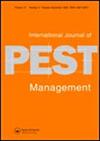昆虫病原真菌在豇豆种子上潜在的防虫剂——斑点小胼蚧和中国小胼蚧
IF 1.1
4区 农林科学
Q3 ENTOMOLOGY
引用次数: 0
摘要
摘要以2 × 106、2 × 107、2 × 108和2 × 109分生菌/kg浓度的豇豆种子为研究对象,评价了4种黑霉、黄绿霉、绿霉和曲霉的杀虫效果。处理后第3天和第7天分别记录成虫死亡率,45天后记录子代和种子失重。7 d后,所有菌株对两种昆虫的成虫死亡率均有显著影响,特别是在2.0 × 109孢子/kg时。在2.0 × 109孢子/kg时,绿僵菌和柠檬酸绿僵菌的死亡率分别为95%和93.2%。中国Callosobruchus对真菌菌株的敏感性略高于maculatus。此外,在最高浓度下,真菌菌株显著降低了两种昆虫的F1后代。处理45 d后,2.0 × 109孢子/kg浓度的哈兹坦菌对豇豆种子的保护效果最好,减重6.5%。研究结果表明,这5株真菌可用于害虫综合治理。关键词:真菌菌株;杀虫效果;生物防治;豇豆种子;本文章由计算机程序翻译,如有差异,请以英文原文为准。
Entomopathogenic fungi as potential biocontrol agents against Callosobruchus maculatus (F.) and Callosobruchus chinensis L. (Coleoptera: Chrisomelidae: Bruchinae) on stored cowpea seeds
AbstractThe insecticidal efficacy of four species of Trichoderma genius (T. harzianum, T. citrinoviride, T. viride and T. asperellum) and Metarhizium anisopliae was assessed against Callosobruchus maculatus and C. chinensis on cowpea seeds at concentrations of 2.0 × 106, 2.0 × 107, 2.0 × 108 and 2.0 × 109 conidia/kg. The adult mortality was counted 3 and 7 days after treatment while progeny and seed weight loss were recorded after 45 days. After 7 days, all fungal strains caused significant adult mortality of both insects particularly at 2.0 × 109 spores/kg. Metarhizium anisopliae and T. citrinoviride were the most effective fungi inducing 95 and 93.2% mortalities of C. chinensis at 2.0 × 109 spores/kg, respectively. Callosobruchus chinensis was slightly more susceptible to the fungal strains than C. maculatus. Furthermore, the fungal strains at the highest concentration caused a significant reduction in F1 progeny of both insects. After 45 days, T. harzianum at 2.0 × 109 spores/kg showed the highest protection of cowpea seeds against C. chinensis with weight loss of 6.5%. These findings indicate that the five fungal strains could be implemented in integrated pest management programs of these insects.Keywords: Fungal strainsinsecticidal efficacybiological controlcowpea seedsBruchinae Disclosure statementNo potential conflict of interest was reported by the author(s).
求助全文
通过发布文献求助,成功后即可免费获取论文全文。
去求助
来源期刊
CiteScore
4.70
自引率
6.70%
发文量
74
审稿时长
>12 weeks
期刊介绍:
International Journal of Pest Management publishes original research papers and reviews concerned with pest management in the broad sense, covering the control of pests (invertebrates, vertebrates and weeds) and diseases of plants, fungi and their products – including biological control, varietal and cultural control, chemical controland interference methods.
The management of invasive species is of special interest. We also encourage submissions dealing with interactions of multiple pests such as arthropods and plant pathogens, pathogens and weeds or weeds and arthropods as well as those dealing with the indirect and direct effects of climate change on sustainable agricultural practices.

 求助内容:
求助内容: 应助结果提醒方式:
应助结果提醒方式:


